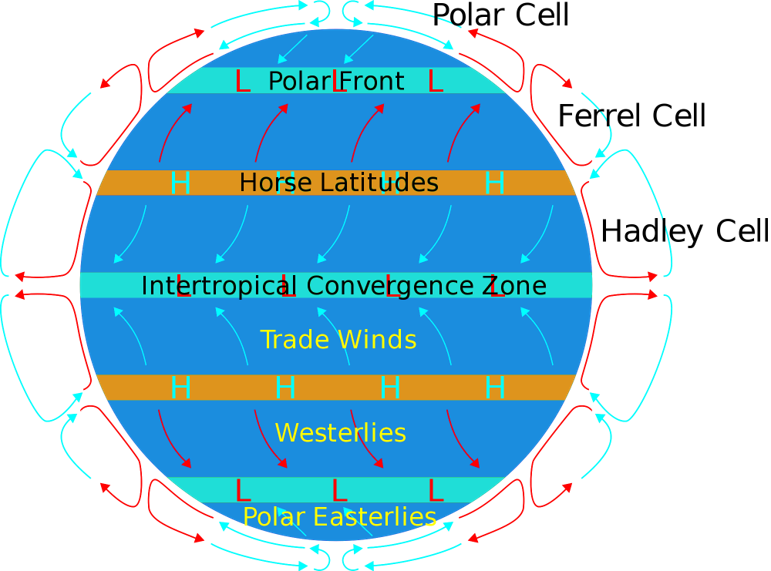Various types of Winds
In this article, we will study the various types of winds found on Earth, whether they blow on planetary level or local.
General Atmospheric Circulation
General Atmospheric Circulation is the movement of wind on the platenary level, due to pressure differences.
General Atmospheric Circulation also causes ocean currents, which influence the earth’s climate.
To understand General Atmospheric Circulation, we need to understand the concept of Cells.
What are Cells?
Air circulations from the surface upwards and then downwards, due to presence of pressure belts are called cells.

There are three such major cells - Hadley, Ferrel, and Polar.
These three cells transfer the heat energy from lower latitudes to higher latitudes.
Let’s study them in detail.
Hadley Cell
High insolation at the Inter-Tropical Convergence Zone (ITCZ) → Air rises because of convection → Low pressure is created at the ground.
Winds from the tropics converge at this low-pressure zone (as easterlies/trade winds). These winds flow westward and are near the surface.
The converged air rises along with the convective cell.
Rising air reaches the top of the troposphere and moves towards the poles → sinks to the ground and forms a subtropical high.
Why and Where the air sinks?
As air moves towards the poles, it gets accumulated at around 30° N and 30° S. Part of it sinks to the ground.
Also, as the air rises it cools down by the time it reaches 30° N and S latitudes. Cold air is denser and therefore heavier. So, it sinks down.
Ferrel Cell
Winds from high latitudes (i.e. from pole side) and the equator side submerge to the ground at mid-latitudes, creating a high-pressure area.
The wind on the ground flows out towards the equator as easterlies and towards the poles as westerlies.
 Note
NoteIn the Ferrel cell the movement of air is the reverse of the airflow in the Hadley cell.
Here air flows:
- poleward and eastward near the surface (as westerlies between 30° and 60° latitudes in both hemispheres) and
- towards the equator at higher altitudes.
Polar Cell
Westerlies from the mid-latitudes move towards high latitude areas along the ground.
Also, cold dense air subsides near the poles → blows towards middle latitudes as the polar easterlies along the ground.
These airs then rise up and move towards the equator and pole at high altitudes.
Local Winds
Land and Sea Breezes
Sea breeze - wind blows from the sea to the land
During the day the land heats up faster and becomes warmer than the sea → over the land the air rises giving rise to a low-pressure area → pressure gradient from sea to land is created.
Land breeze – wind blows from the land to the sea
In the night the conditions are reversed.
The land loses heat faster and is cooler than the sea → pressure gradient from land to sea is created.
Valley breeze and Mountain wind
Valley breeze – wind moving up from the valley. Blows during the day.
Slopes get heated up → air on the slopes moves upslope and gap is created → air from the valley fills up the gapMountain wind – wind moving down towards the valley. Blows during the night.
Slopes get cooled → the air gets cooled and hence dense → this air descends into the valley
